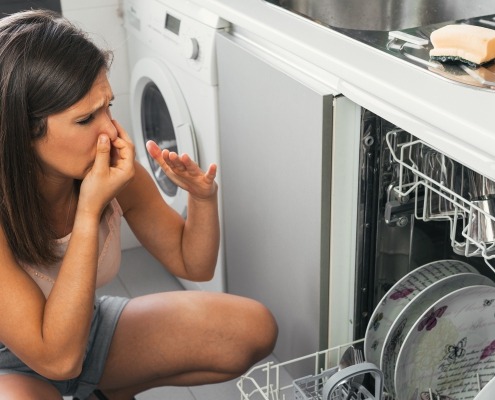How Does a Dishwasher Work?
APP Expert / Friday October 29, 2021
Ever wondered what truly goes on inside your dishwasher beyond the press of a button? If dirty dishes are still plaguing your kitchen despite a seemingly completed wash cycle, it might be time to dive into the inner workings of this indispensable appliance. Discover how you can diagnose and fix common issues with our comprehensive guide—and don’t miss the step-by-step video tutorial just below for a hands-on approach!
Dirty dishes go in, clean ones come out–that’s hopefully how your dishwasher works, right? Of course, it’s not magic. There’s a lot more to it than just pressing a button. It’s actually worth your time to get to know how this appliance works! Why? Well, being familiar with the steps of a typical wash cycle and the major parts of your dishwasher can help you to accurately diagnose problems that may arise. If you know what’s going on in your dishwasher, you can stop a potential issue before it becomes an expensive catastrophe, and fix individual parts as they break, saving you from splurging on a whole new appliance.
We’ve got everything you need to know about how your dishwasher does what it needs to do right here. Ready to take a peek at the inner workings of your appliance? Let’s go!
What’s Inside Your Dishwasher?
Don’t worry, we’re not going to cover every single hinge, screw, and wire harness, but before we get to the step-by-step breakdown of a dishwasher cycle, let’s define a few of the most important parts.
- The Detergent Dispenser. Located on the door, this rectangular storage container holds detergent and rinse aid for a wash cycle. Thanks to the dishwasher’s computer, the dispenser should always release detergent or rinse aid at the proper time during a wash cycle. If it seems like the detergent door isn’t springing open during a cycle, it may need to be cleaned. Lingering detergent from previous washes can gunk up the mechanisms that hold the door shut.
- The Door Latch. This may be obvious, but at the top of your dishwasher door, there’s a latch. This holds the dishwasher door shut while it’s running and it also flips a safety switch that tells the dishwasher’s computer that the washing cycle is allowed to begin. If your dishwasher just isn’t starting up when you tell it to and everything else seems to be in working order, check the door latch!
- The Racks & Silverware Basket. This is where you load your dishes. Dishwashers generally have two or three. Remember to load the racks with every dish facing the center and all cups and bowls turned upside down to get the most out of a wash cycle. Don’t overstuff your silverware basket–you’ll wind up with dirty utensils!
- Spray Arms. Your dishwasher has at least two sets of spray arms — lower and upper — and may have more. As the name implies, these hollow arms spray water to wet and wash dishes during a wash cycle. The pressure of water being pushed up through them causes them to spin, ensuring that dishes are cleaned on all sides.
It’s worth it to check on your spray arms every once in a while to make sure they haven’t been clogged by food debris. It’s pretty easy to clean them with a soft brush or even a toothpick, so long as you’re careful. - The Basin. This is the bottom of your dishwasher. Water collects here to be heated, filtered, and pumped up through the spray arms to clean your dishes.
- The Pump is arguably the most important part of the dishwasher. The circulation pump and motor, typically found beneath the basin, pulls water into the dishwasher at the start of a cycle, pushes it up through the spray arms during the washing phases, and drains it all out at the end of a phase.
If you’re finding standing water in the bottom of your dishwasher after a wash cycle has completely finished, the pump may be having issues. - The Filter or Filtration System. In the bottom of the dishwasher tub, usually the corner or very center, you will find the dishwasher’s filter. This part stops food material from reaching the pump and causing clogs. You should clean your dishwasher’s filter every once in a while.
If you notice that dishes coming out of the wash are still grimy, your filter may need to be cleaned or replaced. - The Water Line & Inlet Valve. There’s a metal hose attaching your dishwasher to your home’s water line by valve. This is how water is brought into the dishwasher. The inlet valve controls the amount of water that is allowed in, ensuring that the basin does not overfill.
- The Drain Line. A white flexible hose connects your dishwasher to your home’s plumbing, allowing water to drain out of the appliance properly.
- The Heating Element. This metal ring may or may not be visible in the basin of your dishwasher. During a wash cycle, this ring activates, heating water to upwards of 140° F. In some models of dishwasher, it can optionally be reactivated at the end of a cycle to heat the air inside the dishwasher and dry the dishes.
How Does a Dishwasher Work?
In a typical dishwasher cleaning cycle, there are three stages. We’ll go over each one, and then break down the steps so you know just what happens when your dishwasher is running.
1. Pre-wash
The pre-wash cycle usually only lasts a few minutes, and is just intended to get dishes wet and do a bit of initial rinsing as the water begins to heat up.
2. Main Wash
This is where the cleaning really gets done. Soapy water heated to around 140° F is continuously pumped through the dishwasher’s spray arms to clean dishes and utensils. It then drips back down into the basin, where it is reheated and filtered to remove debris before being pumped through the spray arms again. You can typically set the length of your wash cycle, but the main wash can last upwards of 60 minutes.
3. Rinse
Eventually, the heating element shuts off and the dirty water drains out. Clean water is pumped in to do a final rinse of your dishes to get rid of any lingering food material or detergent. This portion of the cycle can last up to 60 minutes.
Details of Running a Dishwasher Cycle
So, now that you know the phases of the cycle, here’s specifically what happens when your dishwasher is running:
- The basin fills. Once the wash cycle is started, the water pump pulls water into the bottom of the dishwasher. Just the appliance’s basin is filled, not the whole appliance. A dishwasher is more like a carwash than a swimming pool, after all.
- The dishwasher heats the water. The heating element, typically found in the bottom basin of the dishwasher tub, activates and begins heating the water. Eventually, dishwasher water will reach between 130 and 140° F, but it doesn’t happen immediately. This high heat ensures dishes are sanitized during the clean.
- Heated water is pumped into the spray arms. This starts them spinning, and pre-rinses everything in the dishwasher.
- Detergent is added. At this point, whether you’re using dry, liquid, or pod detergent, the cleaning agent is released into the heated water.
- Washing begins. The heated, soapy water is pumped up through the spray arms, cleaning dishes and utensils. The water then drips back down to the basin where it is reheated, filtered, and sent back up through the spray arms again. This cycle repeats for anywhere from 20 to 60 minutes.
- Dirty water drains out. An internal timer lets the dishwasher know when to end the wash phase and begin rinsing the dishes. At the end of the wash step, dirty water is pumped out of the appliance completely.
- Clean water is pumped into the dishwasher basin. This new batch of clean water is pushed through the spray arms to rinse any remaining food material or soapy residue from your dishes. This cycle, like the wash cycle, can also last for anywhere from 20 to 60 minutes.
- The remaining water is drained. Once the rinse cycle is complete, the water pump activates once more and drains the water used in the rinse cycle from the basin.
- The drying phase begins. Now that the wash is done, the dishes can dry. Residual heat in the tub of the dishwasher can dry dishes, but some models of dishwasher have an option that allows you to dry dishes faster by using the heating element. Opting to allow dishes to dry on their own with heat left behind in the dishwasher is the more energy saving option.
Wrapping Up
Dishwashers haven’t changed too much in the century since the appliance was originally invented. Sure, better tech has made wash cycles more efficient and effective, but when you get down to it, it’s the same as it was when Josephine Cochran invented the first dishwasher in 1886 — using jets of soapy water to clean your flatware.
Now that you know the dishwasher’s parts and just what happens at each step of a wash cycle, you should be able to better pick out the source of a problem if one does arise. And if something does go wrong? Hey, no sweat! You can almost certainly replace that part yourself. If you ever find yourself in need of more tips, tutorials, or replacement appliance parts, keep AppliancePartsPros.com in mind. We can answer your questions about replacing appliance parts.
Where To Find Us
If you need any replacement parts for your appliances, you can enter your model number at AppliancePartsPros.com to locate and order them quickly. Most orders arrive in just two business days, and we have tons of great information in our repair help section and YouTube videos to help you troubleshoot.
Stay connected with the latest DIY tips, tutorial videos, and repair guides by following us on Facebook, Instagram, and Twitter. We love hearing about your repair stories and successes. If you need more help or want personalized guidance, feel free to contact or call us at 877-477-7278. We’re ready to help you take on your next project with confidence!
Since 1999, AppliancePartsPros.com has helped millions of people repair their broken appliances by providing high-quality original parts at well below retail prices, free support and troubleshooting, and award-winning customer service from an expert, friendly, US-based customer support team!
Hi! I’m Matt H., and I’m thrilled to be your guide through the world of appliance repair with over 25 years of invaluable experience in the industry.
From the early days of my career, I have been deeply passionate about appliances and their inner workings. Over the years, I’ve seen it all – from vintage models to the latest cutting-edge technology – and I’ve dedicated myself to mastering the art of repair. With a toolbox in one hand and a wealth of knowledge in the other, I’ve tackled every challenge that has come my way, learning and growing with each repair.
Join me as we dive into the intricacies of appliance repair. From step-by-step repair guides to explanations of common problems and their solutions, I’ll be here to simplify the repair process and empower you with the knowledge you need to keep your appliances running smoothly.
Feel free to explore our blog, ask questions, and leave comments – this platform is a space for learning, sharing, and growing together. Let’s work together to ensure that your appliances continue to serve you for years to come.
Thank you for joining me on this journey, and I look forward to being your go-to resource for all things related to appliance repair!





